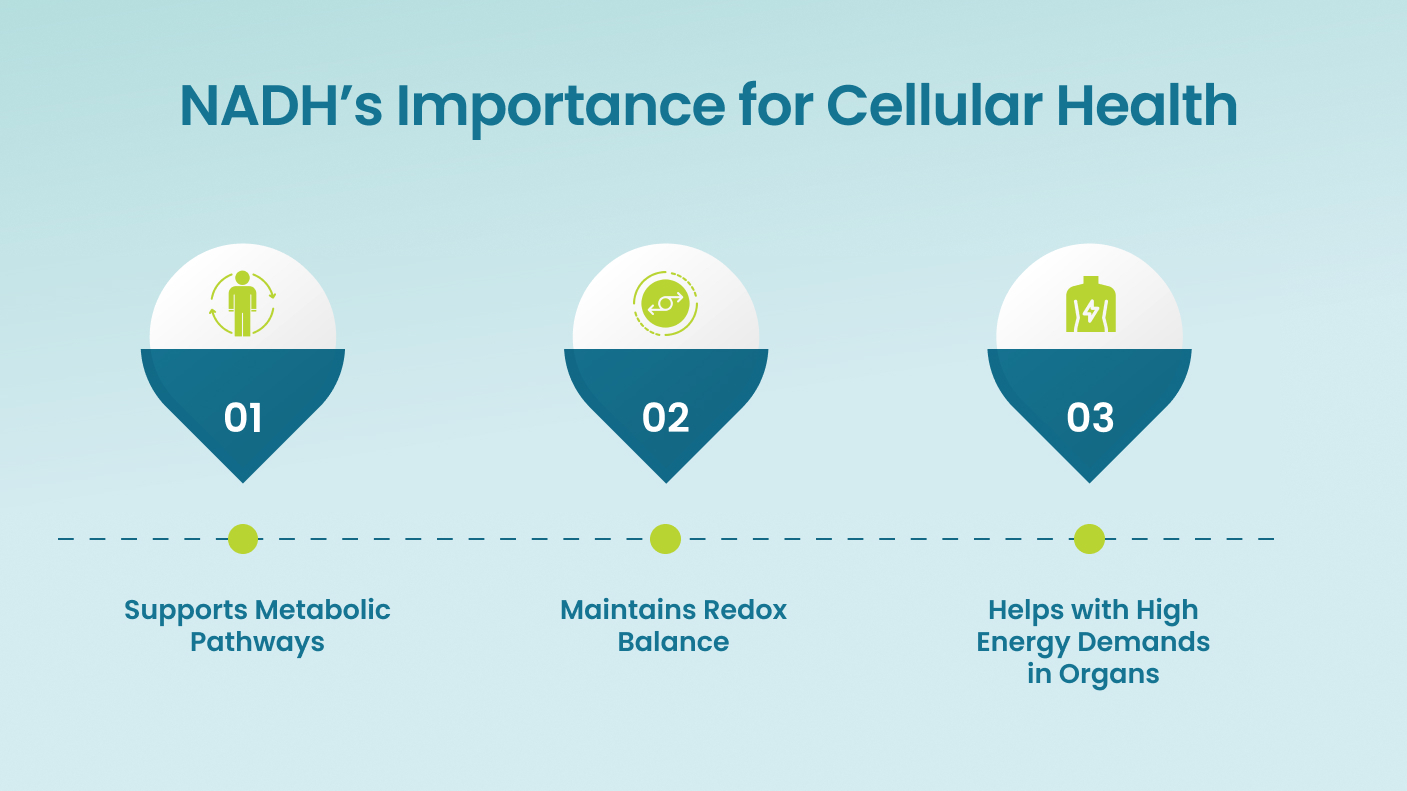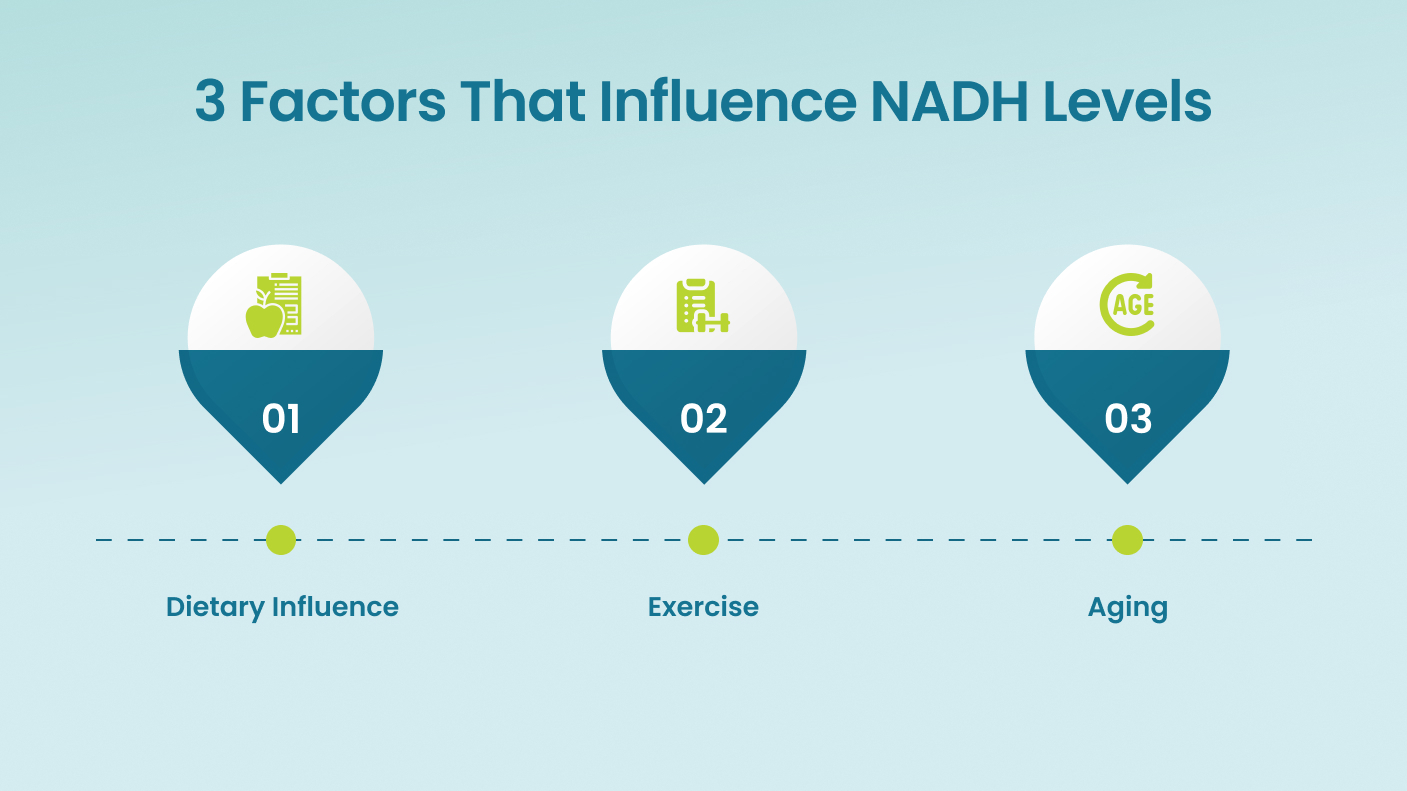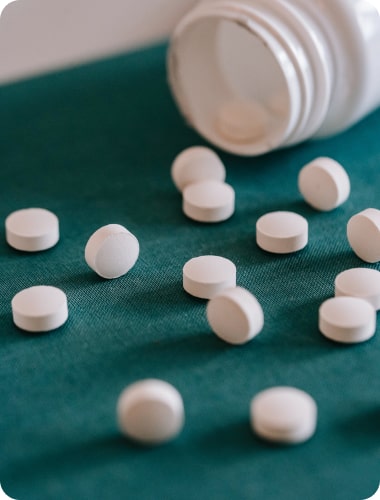
The Role of NADH in Cellular Respiration: Essential Functions and Benefits
NADH, or Nicotinamide Adenine Dinucleotide (in its reduced form), is a powerhouse molecule central to cellular respiration and energy metabolism. It bridges the biochemical breakdown of nutrients and the production of ATP, the energy currency that powers cellular functions. By facilitating energy transfer, NADH ensures that cells, and ultimately the body, function efficiently.
In this blog, we will explore the role of NADH in cellular respiration, explaining its function, importance, and broader implications for energy production and health. We’ll also discuss how NADH levels are influenced by lifestyle, diet, and aging while touching on its potential therapeutic uses.
What is NADH?
NADH is a vital coenzyme that produces cell energy. It is the reduced form of NAD+ (Nicotinamide Adenine Dinucleotide), a critical molecule in redox (reduction-oxidation) reactions. NADH is also an electron carrier that temporarily stores energy by accepting electrons during metabolic reactions.
NAD+ and NADH
- NAD+ Role in Cellular Respiration: NAD+ functions as an electron acceptor, becoming NADH when reduced.
- NADH Function in Cellular Respiration: NADH is a donor that delivers high-energy electrons to the mitochondria for ATP production.
This cyclical conversion between NAD+ and NADH ensures a seamless energy transfer within cells, making it indispensable for life. However, to better understand the role of NADH in cells, you need to understand cellular respiration. Let’s check that out in the next section. If you’re curious how NAD+ supplements and IV therapies can support cellular health, our blog ‘NAD+ IV Therapy Benefits: Unlocking Enhanced Cellular Health’ offers valuable insights.
Cellular Respiration: An Overview
Cellular respiration is how cells convert glucose into ATP, the body’s energy currency. This complex system happens in stages, and NADH plays a vital role at every step, acting as a transporter of energy. Let’s break it down:
i. Glycolysis
The first step, glycolysis, happens in the cytoplasm of the cell. Here’s what takes place:
- Breaking Down Glucose: One glucose molecule is broken into two smaller molecules called pyruvate.
- Energy Capture: During this process, NAD+ (an energy carrier) is turned into NADH by capturing energy released from glucose.
- NADH in Glycolysis: Two NADH molecules are produced per glucose molecule. These NADH molecules carry their stored energy to the mitochondria, where it’s used in later stages.
ii. Citric Acid Cycle (Krebs Cycle)
The second stage, the citric acid cycle, occurs in the mitochondria. It’s where the majority of NADH is produced:
- Starting the Cycle: Pyruvate from glycolysis is converted into acetyl-CoA, which enters the cycle.
- Energy Transfer: NAD+ is turned into NADH at several points as carbon compounds are broken down and their energy is captured.
- NADH’s Function: The NADH produced here acts as the main energy carrier for the final stage of cellular respiration.
iii. Electron Transport Chain (ETC)
The final and most energy-producing stage happens in the inner membrane of the mitochondria:
- NADH’s Big Role: NADH delivers its stored energy by donating electrons to Complex I of the ETC. This starts a series of reactions.
- Powering ATP Production: These reactions pump protons across the mitochondrial membrane, creating a gradient. This gradient powers ATP synthase, an enzyme that makes ATP.
- NADH Oxidation: NADH is “used up” (oxidized) and converted back to NAD+ during this process. This regenerates NAD+ and can be used again in earlier stages, like glycolysis.
NADH is essential for capturing and transferring energy at every stage of cellular respiration. It ensures that the energy from glucose is not wasted but transformed into ATP, the fuel that keeps our cells, and ultimately our bodies, running smoothly.
Understanding NADH’s role in cellular respiration is just the start. Beyond its generation in the metabolic stages, NADH is crucial in efficiently producing ATP and maintaining cell energy flow. Let’s take a closer look at how NADH drives energy metabolism and powers essential cellular functions.
NADH’s Role in Energy Metabolism
NADH is a critical player in cellular energy metabolism, driving ATP production and fueling essential processes that sustain life. As a high-energy electron carrier, NADH ensures a consistent supply of ATP, which powers vital cellular activities.
i. Energy Yield
NADH produces more ATP compared to other molecules like FADH2, making it an efficient and essential energy carrier:
How Much ATP? Each NADH molecule produces approximately 2.5 ATP molecules during cellular respiration, while FADH2 produces only 1.5.
Why the Difference?
- NADH’s Pathway: Electrons from NADH enter the Electron Transport Chain (ETC) at Complex I. This starts a series of reactions that pump protons across the mitochondrial membrane, creating a solid energy gradient.
- FADH2’s Pathway: FADH2 skips Complex I and enters Complex II, bypassing the first proton-pumping step. This results in less ATP being produced.
NADH’s ability to fully engage the ETC makes it a more effective energy carrier, ensuring cells have the energy they need, even during high-demand conditions.
ii. Redox of NADH
NADH plays a crucial role in energy production by undergoing redox (reduction-oxidation) reactions within the ETC:
- NADH Oxidation: NADH releases electrons and hydrogen ions, which fuel a chain of reactions in the ETC. These reactions pump protons across the mitochondrial membrane, creating a gradient known as the proton-motive force.
- ATP Synthesis: The proton gradient powers ATP synthase, an enzyme that converts ADP into ATP, the primary energy source for the cell.
- NAD+ Regeneration: When NADH is oxidized, it regenerates NAD+, which is essential for earlier stages of energy production, like glycolysis and the citric acid cycle.
Without this continuous redox cycle, cellular respiration would come to a standstill, causing energy shortages in the cell. NADH ensures that energy flows seamlessly, making it vital for life and cellular function.
In addition to its role in energy metabolism, NADH is crucial for maintaining cellular health. It drives processes like DNA repair, protein synthesis, and redox balance, ensuring efficient and resilient cellular function. Let’s dive into these essential roles.
The Critical Role and Importance of NADH in Cellular Function
NADH is essential for both energy production and maintaining overall cellular health. As a high-energy electron donor, it synthesizes ATP while supporting other vital processes that ensure cellular functionality and long-term vitality.
i. NADH in Energy Production

NADH plays a central role in cellular respiration, particularly during oxidative phosphorylation, where it directly contributes to ATP synthesis:
- Electron Donation: NADH delivers electrons to Complex I of the Electron Transport Chain (ETC), triggering a cascade of reactions. This electron transfer drives the pumping of protons across the mitochondrial membrane.
- Proton Gradient Creation: The energy from NADH’s electrons creates the proton-motive force, an electrochemical gradient that powers ATP synthase. ATP synthase uses this gradient to produce most ATP molecules in the cell.
- Regeneration of NAD+: When NADH is oxidized in the ETC, it regenerates NAD+, which is crucial for earlier energy-producing stages like glycolysis and the citric acid cycle.
NADH is the backbone of energy metabolism, ensuring an efficient flow of electrons and sustained ATP production. This supports both immediate energy needs and long-term cellular health.
ii. NADH’s Importance for Cellular Health

Beyond producing energy, NADH supports other key processes vital for cellular health and survival:
- Supports Metabolic Pathways: NADH powers enzymatic reactions necessary for DNA repair, protein synthesis, and detoxification, which are critical for cellular growth and survival.
- Maintains Redox Balance: The cycling of NAD+/NADH helps prevent oxidative stress by maintaining a healthy redox balance within cells. This is particularly important in high-energy-demanding tissues like the brain, heart, and muscles, where oxidative damage can impair function.
- Helps with High Energy Demands in Organs: Organs with significant energy needs—such as the brain, heart, and muscles—depend heavily on NADH to fuel their activities. Insufficient NADH can lead to issues like fatigue, cognitive decline, and decreased physical performance.
NADH’s ability to support energy production, maintain redox balance, and drive essential metabolic pathways makes it indispensable for cellular vitality and overall health.
After understanding the critical roles NADH plays in energy production and cellular health, it’s essential to explore what affects its availability. Factors like diet, exercise, aging, and overall health directly influence NADH levels, shaping their impact on cellular function and metabolic efficiency. Let’s examine these influences in detail.
3 Factors That Influence NADH Levels

NADH levels are influenced by internal and external factors such as diet, exercise, aging, and overall health. These factors directly impact cellular energy production and metabolic efficiency.
1. Dietary Influence
Diet plays a crucial role in NADH production by providing the precursors required for NAD+ synthesis:
- Niacin-rich foods: Foods high in Vitamin B3, such as meat, fish, nuts, and grains, support NAD+ production. NAD+ is converted into NADH during metabolic processes, fueling cellular energy production.
- Role of NADH: NADH derived from dietary sources drives ATP synthesis and supports essential metabolic pathways.
- Caloric Restriction: Limiting calorie intake can enhance the NAD+/NADH balance, promoting more efficient energy metabolism and potentially slowing aging-related decline.
2. Exercise
Physical activity significantly enhances NADH production and mitochondrial function, particularly in muscle cells:
- Enhanced Energy Needs: Muscles in active use rely heavily on NADH to meet higher energy demands, improving overall metabolic efficiency.
- Long-Term Impact: Regular exercise helps maintain a healthier NAD+/NADH ratio, delaying age-related declines in energy metabolism and supporting sustained cellular health.
3. Aging
Aging naturally reduces NADH levels due to a decline in NAD+/NADH ratios:
- Metabolic Slowdown: Aging decreases the efficiency of NAD+ recycling, leading to reduced NADH availability.
- Energy Impact: Lower NADH levels contribute to fatigue, diminished physical performance, and susceptibility to age-related diseases.
- Mitigation Strategies: A nutrient-rich diet, regular exercise, and NAD+ supplements, such as nicotinamide riboside (NR) or nicotinamide mononucleotide (NMN), can help restore NADH levels and improve energy metabolism.
Now that you know that the NADH reservoir in your body isn’t neverending, factors like health, age, etc., may accelerate its depletion, potentially harming your overall well-being—which we’ll discuss in the upcoming section.
NADH in Health and Disease
Optimal NADH levels are crucial for maintaining health and managing various conditions. As a central player in energy production and redox regulation, NADH directly impacts cellular resilience and the functioning of vital organs. Let’s explore its significance in specific health contexts and potential therapeutic benefits.
i. Mitochondrial Health
- Key Role in Energy-Intensive Organs: NADH drives ATP production in high-energy-demanding organs like the brain, heart, and muscles, which rely on a constant energy supply to function optimally.
- Oxidative Stress Reduction: NADH supports redox cycling, which helps neutralize oxidative stress and protect cells from damage. This resilience is critical for cellular longevity and overall health.
ii. Chronic Fatigue and Metabolic Disorders
- Chronic Fatigue Syndrome (CFS): Low NADH levels are closely linked to fatigue and diminished energy production. Research suggests NADH supplements help alleviate CFS symptoms by enhancing mitochondrial efficiency and ATP output.
- Metabolic Disorders: Disrupted NAD+/NADH ratios in conditions like diabetes and obesity impair energy metabolism. Restoring this balance can improve metabolic flexibility, insulin sensitivity, and overall cellular function.
As NADH’s role in these health conditions becomes clearer, its therapeutic potential has gained significant attention. Researchers are now exploring how NADH supplementation and its applications could support health, enhance performance, and address disease-related deficiencies.
NADH Supplement Benefits
NADH supplementation shows promise in several areas, including energy support, cognitive enhancement, and recovery:
- Energy Support: Supplements can boost energy levels, improving physical performance and endurance, particularly in individuals experiencing fatigue. To discover the best NAD+ supplement options and dosages, check out our detailed guide: Ideal NAD+ Injection Dosage Per Day: Everything You Need to Know.
- Cognitive Health: NADH enhances brain function, especially for energy-demanding cognitive tasks, which is potentially beneficial in conditions involving cognitive decline.
- Recovery: NADH may accelerate recovery from fatigue and improve performance in
Therapeutic Potential
Emerging research highlights additional therapeutic applications of NADH:
- Neurodegenerative Diseases: Early studies indicate that NADH may help reduce oxidative damage and support mitochondrial health in conditions like Alzheimer’s and Parkinson’s.
- Anti-Aging Therapies: NADH is being investigated for its potential to slow age-related cellular decline by enhancing energy metabolism and maintaining redox balance. However, further research is needed to confirm its long-term benefits.
By supporting mitochondrial health, alleviating fatigue, and potentially addressing age-related and neurodegenerative conditions, NADH plays a vital role in maintaining wellness and offering new therapeutic opportunities. As research progresses, its full potential in health management continues to unfold.
To optimize NADH levels, consider lifestyle factors such as a nutrient-rich diet and regular exercise. Moreover, NADH supplements or therapies may benefit those seeking additional support, especially for energy-intensive lifestyles or health challenges. And if you’re on a similar journey–where you want to replenish your body’s NAD+/ NADH levels—then IV Drips is the place for you!
Achieve Overall Cellular Wellness with IV Drips NAD+ Therapy Options
At IV Drips, we prioritize your health and vitality by offering personalized NAD+ therapy solutions to meet your unique needs. Our diverse therapy options are tailored to fit different lifestyles, ensuring everyone can experience the transformative effects of NAD+:
- NAD+ Infusions: Experience the full benefits of NAD+ therapy with our expertly administered IV infusions formulated for maximum absorption and efficacy.
- NAD+ Self-Injections: For those seeking convenience and flexibility, our self-injection option allows you to manage your NAD+ therapy from the comfort of your home.
- NAD+ Nasal Spray: Our convenient and easy-to-use nasal spray delivers NAD+ directly to your system, offering a unique absorption method for potential cognitive and neurological benefits.
Why Choose NAD+ Therapy?
NAD+ therapy offers a wide range of health benefits, helping you feel your best:
- Increase energy levels and combat fatigue
- Enhance focus, memory, and overall mental sharpness
- Boost mood and promote emotional balance
- Rejuvenate cells and support long-term cellular health
Revitalize your body and mind with NAD+ therapy. Schedule your IV Drips session today and experience the difference!
Posted on behalf of IVDrips











